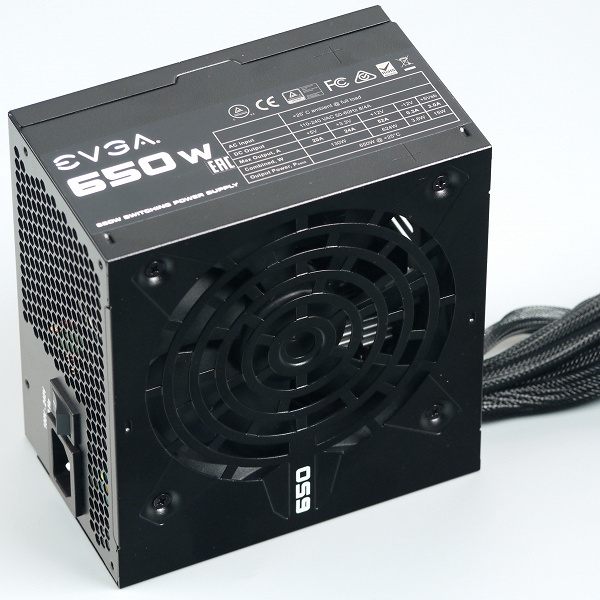
EVGA also has budget power supplies in its range. We will get acquainted with them on the example of one of the representatives of the N1 series – EVGA 650 N1 . In total, this series includes four models with a capacity of 400, 550, 650 and 750 watts. For assembling a budget computer, the younger models are of the greatest interest, but for various reasons we have a 650 W model on hand, so for now let’s get acquainted with it.
The length of the power supply case is standard and is about 140 mm, this model can fit in any computer case that supports the installation of ATX format power supplies. The case has a matte black finish with a fine texture, there are almost no handprints on such a coating. All wires are non-removable.

The packaging of the power supply is a cardboard box of sufficient strength with matte printing. The design is dominated by shades of black.
Characteristics
All the necessary parameters are indicated on the power supply case in full, for the power of the + 12VDC bus, the value of 624 W is declared. The ratio of power on the bus + 12VDC and full power is 0.96, which is quite worthy.
The manufacturer separately notes that the power supply is capable of delivering maximum power at an ambient temperature of no higher than 25 ° C. For Russian climatic conditions, this option is not satisfactory. It should be borne in mind that for computer power supplies, the recommended operating temperature is in the range from +10 to +50 degrees. But in the case of budget products, such a limitation is very common.

Wires and Connectors
| Connector name | Number of connectors | Notes |
|---|---|---|
| 24 pin Main Power Connector | one | collapsible |
| 4 pin 12V Power Connector | — | |
| 8 pin SSI Processor Connector | one | collapsible |
| 6 pin PCI-E 1.0 VGA Power Connector | — | |
| 8 pin PCI-E 2.0 VGA Power Connector | 2 | on one line |
| 4 pin Peripheral Connector | 3 | |
| 15 pin Serial ATA Connector | 6 | on two cords |
| 4 pin Floppy Drive Connector | one |
Length of wires to power connectors
- to the main ATX connector – 55 cm
- to processor socket 8 pin SSI – 62 cm
- to the first PCI-E 2.0 VGA Power Connector – 55 cm, plus another 12 cm to the second of the same connector
- to the first SATA Power Connector – 45 cm, plus 12 cm to the second and another 12 cm to the third of the same connector
- to the first SATA Power Connector – 45 cm, plus 12 cm to the second and another 12 cm to the third of the same connector
- to the Peripheral Connector (“molex”) – 45 cm, plus 12 cm to the second and another 12 cm to the third of the same connector, plus another 12 cm to the FDD power connector

The length of the wires is sufficient for comfortable use in full tower and larger cases with a top-mounted power supply. In cases up to 55 cm high with a bottom-mounted power supply, the length of the wires should also be sufficient: a little more than 60 centimeters to the processor power connector. Thus, with most modern cases, there should be no problems. True, taking into account the design of modern cases with advanced systems of hidden wiring, the cord with the processor power connector could well be made longer: say, from 70 cm, to ensure maximum convenience when assembling the system.
There are enough SATA Power connectors for a solution of this level, and they are located on two power cords. The connectors are straight, which is convenient in the case of drives placed on the back of the motherboard base.
Circuitry and cooling
The power supply is equipped with an active power factor corrector and has an extended supply voltage range from 100 to 240 volts. This ensures resistance to voltage drops in the mains below the standard values.
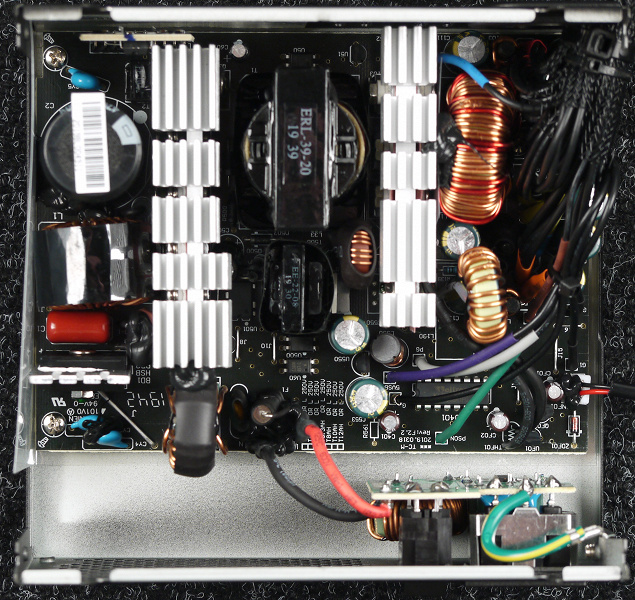
The main semiconductor elements are mounted on two medium-sized radiators. The first contains elements of AC circuits, and the second – rectifiers.
The platform here is clearly not the most advanced: group stabilization of the + 5VDC and + 12VDC channels, as well as + 3.3VDC on a separate stabilizer based on a magnetic amplifier, is implemented. Everything is quite typical for budget segment solutions.
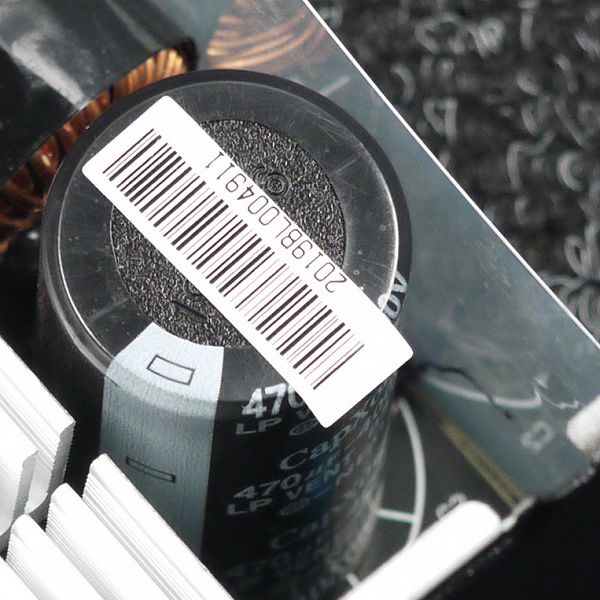
Capacitors in the power supply are mostly represented by products under the Teapo and Capxon trademarks. This is far from the worst option for a budget product.

The 120mm EFS-12E12H fan is manufactured by DWPH and is based on a sleeve bearing.
Measurement of electrical characteristics
Next, we turn to an instrumental study of the electrical characteristics of the power source using a multifunctional stand and other equipment.
The deviation of output voltages from the nominal value is color-coded as follows:
| Colour | Deviation range | Qualitative assessment |
|---|---|---|
| more than 5% | unsatisfactory | |
| +5% | bad | |
| +4% | satisfactorily | |
| +3% | well | |
| +2% | very good | |
| 1% or less | Great | |
| −2% | very good | |
| −3% | well | |
| −4% | satisfactorily | |
| −5% | bad | |
| more than 5% | unsatisfactory |
Working at maximum power
The first stage of testing is the operation of the power supply at maximum power for a long time. Such a test with confidence allows you to verify the performance of the PSU.

The power supply successfully started at the maximum declared power and worked for more than 30 minutes. In the future, the performance was also preserved.
Cross load characteristic
The next stage of instrumental testing is the construction of a cross-load characteristic (CNC) and its presentation on a quarter-plane, limited by the maximum power on the 3.3 & 5 V bus on the one hand (along the ordinate axis) and the maximum power on the 12 V bus on the other (along the abscissa axis). At each point, the measured voltage value is indicated by a color marker depending on the deviation from the nominal value.
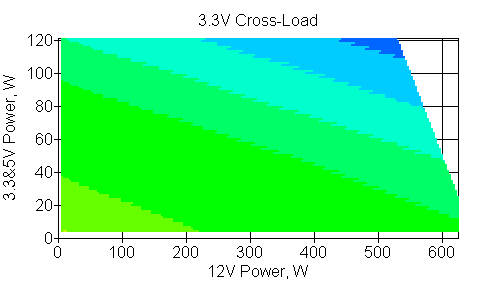
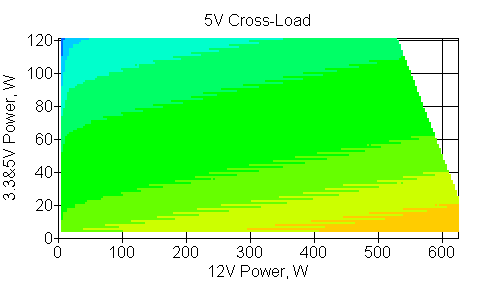

KNH allows us to determine what level of load can be considered acceptable, especially on the + 12VDC channel, for the instance under test. In this case, the deviations of the effective voltage values from the nominal value through the +12VDC channel do not exceed 4% over the entire power range, which is a satisfactory result.
With a typical power distribution over the channels, deviations from the nominal value do not exceed 2% for the +3.3VDC and +12VDC channels and 4% for the +5VDC channel.
The power supply allows you to provide a load with a total consumption of at least 400 W via the + 12VDC channel. With a further increase in consumption on the +12VDC channel, the voltage deviation on the +5VDC channel increases.
load capacity
The following test is designed to determine the maximum power that can be supplied through the appropriate connectors with a normalized voltage deviation of 3 or 5 percent of nominal.

In the case of a video card with a single power connector, the maximum power through the +12VDC channel is at least 150 W with a deviation of 3%.

In the case of a video card with two power connectors, when using one power cord, the maximum power through the +12VDC channel is at least 250 W with a deviation within 3%.

When loaded through the processor power connector, the maximum power through the +12VDC channel is at least 250 W with a deviation within 3%. This allows you to use mid-level desktop platforms with a tangible margin.

In the case of a motherboard, the maximum power per channel + 12VDC is at least 100 W with a deviation of no more than 3% from the nominal value. Since the board itself consumes within 10 W on this channel, high power may be required to power expansion cards – for example, for video cards without an additional power connector, which usually have a consumption of around 75 W. Thus, there should be no problems here.
Economy and efficiency
When evaluating the efficiency of a computer power supply, there are two ways to go. The first way is to evaluate the computer power supply as a separate electrical energy converter with a further attempt to minimize the resistance of the power transmission line from the PSU to the load (where the current and voltage at the PSU output are measured). To do this, the power supply is usually connected with all available connectors, which puts different power supplies in unequal conditions, since the set of connectors and the number of current-carrying wires are often different even for power supplies of the same power. Thus, although the results are correct for each specific power supply, in real conditions the data obtained is of little use, since in real conditions the power supply is connected to a limited number of connectors, and not all at once. Therefore, it seems logical to determine the efficiency (economics) of a computer power supply not only at fixed power values, including power distribution over channels, but also with a fixed set of connectors for each power value.
Representing the efficiency of a computer power supply in the form of an efficiency value (coefficient of performance) has its own traditions. First of all, efficiency is a coefficient determined by the ratio of the output and input powers of the power supply, that is, the efficiency shows the efficiency of converting electrical energy. For an ordinary user, this parameter will tell almost nothing, except that a higher efficiency seems to indicate a greater efficiency of the PSU and its higher quality. But efficiency has become a great marketing anchor, especially when combined with the 80Plus certification. However, from a practical point of view, efficiency does not have a noticeable effect on the functioning of the system unit: it does not increase performance, does not reduce noise or temperature inside the system unit. This is just a technical parameter, the level of which is mainly determined by the development of the industry at the current time and the cost of the product. For the user, maximizing efficiency results in an increase in the retail price.
On the other hand, sometimes you need to objectively evaluate the efficiency of a computer power supply. By efficiency, we mean the loss of power during the conversion of electricity and its transmission to end consumers. And to evaluate this efficiency is not needed, since you can use not the ratio of two values, but absolute values: power dissipation (the difference between the values u200bu200bof the input and output of the power supply), as well as the energy consumption of the power supply for a certain time (day, month, year etc.) when working with a constant load (power). This makes it easy to see the real difference in power consumption of specific PSU models and, if necessary, calculate the economic benefit of using more expensive power supplies.
Thus, at the output we get a parameter that is understandable to everyone – dissipated power, which is easily converted into kilowatt-hours (kWh), which is recorded by the electric energy meter. Multiplying the obtained value by the cost of a kilowatt-hour, we get the cost of electrical energy, provided that the system unit is operated around the clock throughout the year. Such an option, of course, is purely hypothetical, but it allows you to evaluate the difference between the cost of operating a computer with different power sources for a long period of time and draw conclusions about the economic feasibility of purchasing a particular PSU model. In real conditions, the calculated value can be achieved over a longer period – for example, from 3 years or more. If necessary, everyone can divide the obtained value by the desired coefficient, depending on the number of hours per day during which the system unit is operated in the specified mode in order to obtain electricity consumption for the year.
We decided to single out several typical options in terms of power and correlate them with the number of connectors that correspond to these options, that is, to bring the method of measuring efficiency as close as possible to the conditions that are achieved in a real system unit. At the same time, this will allow you to evaluate the efficiency of different power supplies in completely identical conditions.
| Load through connectors | 12VDC, W | 5VDC, W | 3.3VDC, W | Total power, W |
|---|---|---|---|---|
| main ATX, processor (12 V), SATA | 5 | 5 | 5 | fifteen |
| main ATX, processor (12 V), SATA | 80 | fifteen | 5 | 100 |
| main ATX, processor (12 V), SATA | 180 | fifteen | 5 | 200 |
| main ATX, processor (12V), 6-pin PCIe, SATA | 380 | fifteen | 5 | 400 |
| Main ATX, CPU (12V), 6-pin PCIe (1 cord with 2 connectors), SATA | 480 | fifteen | 5 | 500 |
| main ATX, processor (12 V), 6-pin PCIe (2 cords by 1 connector), SATA | 480 | fifteen | 5 | 500 |
| main ATX, processor (12V), 6-pin PCIe (2 cords of 2 connectors), SATA | 730 | fifteen | 5 | 750 |
The results are as follows:
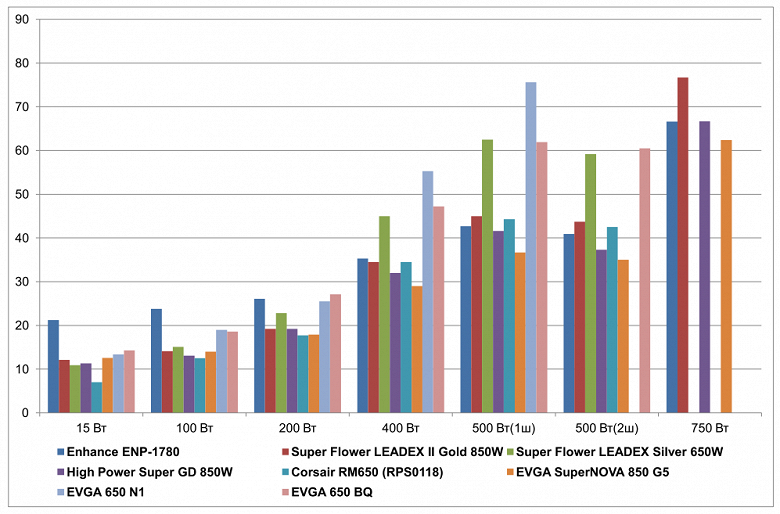
| Dissipated power, W | 15 W | 100 W | 200 W | 400 W | 500 W (1 cord) |
500 W (2 cords) |
750 W |
|---|---|---|---|---|---|---|---|
| Enhance ENP-1780 | 21.2 | 23.8 | 26.1 | 35.3 | 42.7 | 40.9 | 66.6 |
| Super Flower Leadex II Gold 850W | 12.1 | 14.1 | 19.2 | 34.5 | 45 | 43.7 | 76.7 |
| Super Flower Leadex Silver 650W | 10.9 | 15.1 | 22.8 | 45 | 62.5 | 59.2 | |
| High Power Super GD 850W | 11.3 | 13.1 | 19.2 | 32 | 41.6 | 37.3 | 66.7 |
| Corsair RM650 (RPS0118) | 7 | 12.5 | 17.7 | 34.5 | 44.3 | 42.5 | |
| EVGA SuperNova 850 G5 | 12.6 | fourteen | 17.9 | 29 | 36.7 | 35 | 62.4 |
| EVGA650N1 | 13.4 | nineteen | 25.5 | 55.3 | 75.6 | ||
| EVGA 650 BQ | 14.3 | 18.6 | 27.1 | 47.2 | 61.9 | 60.5 |
The higher the load power, the worse the efficiency of this model looks, but this is quite typical for budget solutions. In real conditions, it is unlikely that someone will load this power supply above 400 watts.
| Tue | |
| Enhance ENP-1780 | 106.4 |
| Super Flower Leadex II Gold 850W | 79.9 |
| Super Flower Leadex Silver 650W | 93.8 |
| High Power Super GD 850W | 75.6 |
| Corsair RM650 (RPS0118) | 71.7 |
| EVGA SuperNova 850 G5 | 73.5 |
| EVGA650N1 | 113.2 |
| EVGA 650 BQ | 107.2 |
At low and medium power, the consumption here is not the lowest, which is consistent with the level of the certificate and the positioning of the product as a whole.
| Computer energy consumption per year, kWh | 15 W | 100 W | 200 W | 400 W | 500 W (1 cord) |
500 W (2 cords) |
750 W |
|---|---|---|---|---|---|---|---|
| Enhance ENP-1780 | 317 | 1085 | 1981 | 3813 | 4754 | 4738 | 7153 |
| Super Flower Leadex II Gold 850W | 237 | 1000 | 1920 | 3806 | 4774 | 4763 | 7242 |
| Super Flower Leadex Silver 650W | 227 | 1008 | 1952 | 3898 | 4928 | 4899 | |
| High Power Super GD 850W | 230 | 991 | 1920 | 3784 | 4744 | 4707 | 7154 |
| Corsair RM650 (RPS0118) | 193 | 986 | 1907 | 3806 | 4768 | 4752 | |
| EVGA SuperNova 850 G5 | 242 | 999 | 1909 | 3758 | 4702 | 4687 | 7117 |
| EVGA650N1 | 249 | 1042 | 1975 | 3988 | 5042 | ||
| EVGA 650 BQ | 257 | 1039 | 1989 | 3918 | 4922 | 4910 |
Temperature regime

The thermal loading of capacitors in the PSU is relatively low over the entire power range.
Acoustic ergonomics
In preparing this material, we used the following method for measuring the noise level of power supplies. The power supply is located on a flat surface with the fan up, above it at a distance of 0.35 m is placed the measuring microphone of the Octava 110A-Eco sound level meter, which measures the noise level. The power supply is loaded using a special stand that has a silent mode of operation. During the noise level measurement, the power supply is operated at constant power for 20 minutes, after which the noise level is measured.
Such a distance to the measurement object is the closest for the desktop placement of the system unit with the power supply installed. This method allows you to evaluate the noise level of the power supply in harsh environments in terms of a small distance from the noise source to the user. As the distance to the noise source increases and additional barriers appear that have good sound reflecting ability, the noise level at the control point will also decrease, which will lead to an improvement in acoustic ergonomics in general.

When operating in the range up to 200 W, the noise of the power supply is at a relatively low level (below the average). Such noise will be hardly noticeable against the background of typical background noise in the room during the daytime, especially when operating this power supply in systems that do not have any sound-noise optimization. In normal living conditions, most users rate devices with similar acoustic ergonomics as relatively quiet.
At a power of 300 W, the noise can be considered average for a residential area during the daytime. This level of noise is quite acceptable when working at a computer.
With a further increase in output power, the noise level increases markedly. At a load of 400 W, the noise of the power supply already exceeds the value of 40 dBA when placed on a desktop, that is, when the power supply is located in the near field in relation to the user. This noise level can be described as quite high.
At maximum power, the noise level was about 51 dBA. This noise level can be considered very high.
Thus, in terms of acoustic ergonomics, this model provides comfort with an output power within 300 watts.
We also evaluate the noise level of the power supply electronics, since in some cases it is a source of unwanted overtones. This stage of testing is carried out by determining the difference between the noise level in our laboratory with the power supply on and off. If the obtained value is within 5 dBA, there are no deviations in the acoustic properties of the PSU. With a difference of more than 10 dBA, as a rule, there are certain defects that can be heard from a distance of about half a meter. At this stage of measurements, the sound level meter microphone is located at a distance of about 40 mm from the upper plane of the PSU, since it is very difficult to measure electronic noise at greater distances. The measurement is carried out in two modes: standby mode (STB, or Stand by) and when the PSU is working on the load, but with the fan forcedly stopped.
In standby mode, electronic noise is almost completely absent. In general, the noise of electronics can be considered low: the excess of background noise was no more than 2 dBA.
Consumer qualities
The consumer qualities of the EVGA 650 N1 are at an average level, if we consider the use of this model in a home system that uses typical components.
The acoustic ergonomics of the PSU is not the most outstanding, since at a load of more than 300 W it already makes quite noticeable noise. However, in the real world, components with this consumption will produce significant noise on their own. At the same time, in idle mode and low load (up to 200 W), the power supply is relatively quiet.
The length of the wires at the PSU is quite sufficient for modern mid-budget cases.
We note the high load capacity of the platform via the +12VDC channel, as well as a large number of connectors (to solve such a cost).
Results
The EVGA 650 N1 power supply allows you to use one powerful video card and a modern mid-budget platform with a total consumption of at least 400 W per channel + 12VDC. With a further increase in consumption on the +12VDC channel, the voltage deviation on the +5VDC channel increases, and the noise level also increases greatly.
This power supply is well suited for operation in modern systems, since it has a high practical load capacity through the +12VDC channel, and can also operate at maximum power without loss of performance.
Indeed, we have a budget product, but taking into account some nuances, it is quite suitable for use in low-power systems.





